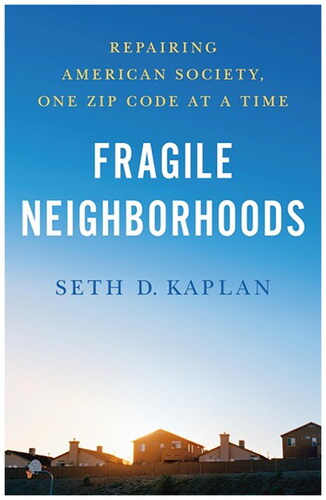In Fragile Neighborhoods, Seth Kaplan argues that the federal government has failed at neighborhood revitalization because it has insufficiently emphasized social networks, local organizations, and personal values:
A more effective way to repair and revitalize fragile places is to work horizontally across the landscape to strengthen the interconnected web of institutions and relationships locale by locale while finding ways for each locale to work with the others better. (p. 17)
In the Dexter-Linwood neighborhood of Detroit, Chris Lambert and a nonprofit organization called Life Remodeled brought families together to repair homes, renovate a high school into a community hub (the Durfee Innovation Society), and beautify the area. Lambert won the trust of residents who were concerned about possible gentrification by showing up at meetings and demonstrating a willingness “to listen, learn and be vulnerable” (p. 68). According to Kaplan, this effort was a “huge success”; crime dropped, property values increased, and physical conditions around the school-turned-community hub improved substantially.
Partners for Education (PFE) in Berea (KY) responded to a unique challenge to social repairers in rural Appalachia; residents view outsiders with suspicion. PFE’s mission has been “to instill in students a deep sense of pride and belonging and to change the narrative of a region in decline” (p. 88). To do this, PFE places local artists in residence in schools to provide instruction in local arts because they believe that engaging with the arts enhances a sense of belonging and improves educational performance. PFE has achieved its educational goals in Appalachian Kentucky by raising graduation rates and, when implemented in conjunction with other special programs, reading scores, kindergarten readiness, and math and English proficiency levels have increased beyond the state’s average.
Project Thread in Baltimore (MD) focuses on one of the most serious neighborhood revitalization challenges: how to respond to large numbers of children raised in unstable homes and in high-crime neighborhoods where single-parent households are the norm. Project Thread’s social support system surrounds each student from elementary to high school through transition to college, and to their first job, by adding a second family of volunteers to drive students to school, assist with homework, and provide food if necessary. According to Kaplan, Thread participants graduate from high school at 10 times the rate of their peers (65% versus 6%).
The institution of marriage is in trouble in America. A nonprofit called Communio, which started in Florida, is working through churches to achieve improved marriage outcomes. Communio relies on sophisticated data analytics to help churches market specific programs, such as group date nights, couples’ coaching, and communications training. According to Kaplan, Duval County (FL) experienced a 24% drop in divorces over a 3-year period after the program was implemented.
Of the five social repair programs, the East Lake Foundation’s (ELF) effort in Atlanta (GA) is by far the most holistic. The strategy has included replacing a deteriorating public housing project with mixed-income housing, building a charter school, and revitalizing the commercial district. ELF serves as the neighborhood revitalization quarterback raising millions of dollars from public and private sources, ensuring that investors, philanthropists, and public agencies work together, and guaranteeing that residents were actively engaged in the planning process. As a result of ELF, children’s test scores and property values have increased, crime and poverty rates have decreased, and East Lake’s revitalization has spilled over to adjoining East Atlanta neighborhoods.
Although Kaplan acknowledges these five strategies are not panaceas, he overstates their effectiveness. For example, he provides no evidence that Thread has helped the original student families out of poverty or that the program has changed neighborhood dynamics in inner-city Baltimore. Furthermore, he does not show how the Communio model would work in struggling inner-city communities where the incidence of single parenthood is especially high. Finally, his story of ELF’s success fails to mention that the original public housing residents did not benefit from revitalization because most moved elsewhere during the construction period, or that the revitalization effort benefited from Atlanta’s hot housing market.
Kaplan’s concern about neighborhood fragility includes the suburban middle class. Because American culture prioritizes me over the community in community affairs, involvement in civic organizations is decreasing while loneliness is increasing. According to Kaplan, in general, Americans should slow down and prioritize family, children, neighborhood, community, and local institutions. Kaplan wisely draws on his own family’s experience living in suburban Kemp Mill (MD), a Modern Orthodox Jewish community just north of Washington (DC). Sabbath observance played a key role with no driving, no shopping, and no cooking, thereby creating a lifestyle that grounds his family by “distancing them from the larger society, but bringing [them] and their neighbors closer together” (p. 185). Obviously, an Orthodox Jewish lifestyle will not be possible for most U.S. citizens, but Kaplan’s experience shows what this type of living offers.
Unfortunately, there are no photographs or maps, but the book is exceptionally well written and well researched. Fragile Neighborhoods offers valuable professional advice for JAPA readers involved in neighborhood planning. That is, planners ought to concentrate on as many causes of neighborhood decline as possible (families, schools, shopping) and should focus resources where they can be most effective. For academics, the book reinforces the conclusion that revitalization efforts can only have a modest impact and that they need to be complemented by policies at the metropolitan level to address economic and cultural forces driving decline. Finally, the book deserves an audience of lay citizens. By following Kaplan’s advice, readers can enhance their own and their family’s quality of life by pursuing a more neighborhood-oriented lifestyle.
Additional information
Notes on contributors
David Varady
DAVID P. VARADY is emeritus professor of planning at the University of Cincinnati and was a visiting scholar at the University of Porto (Portugal) in 2020. His research interests include public housing, housing vouchers, segregation, and neighborhood revitalization.

